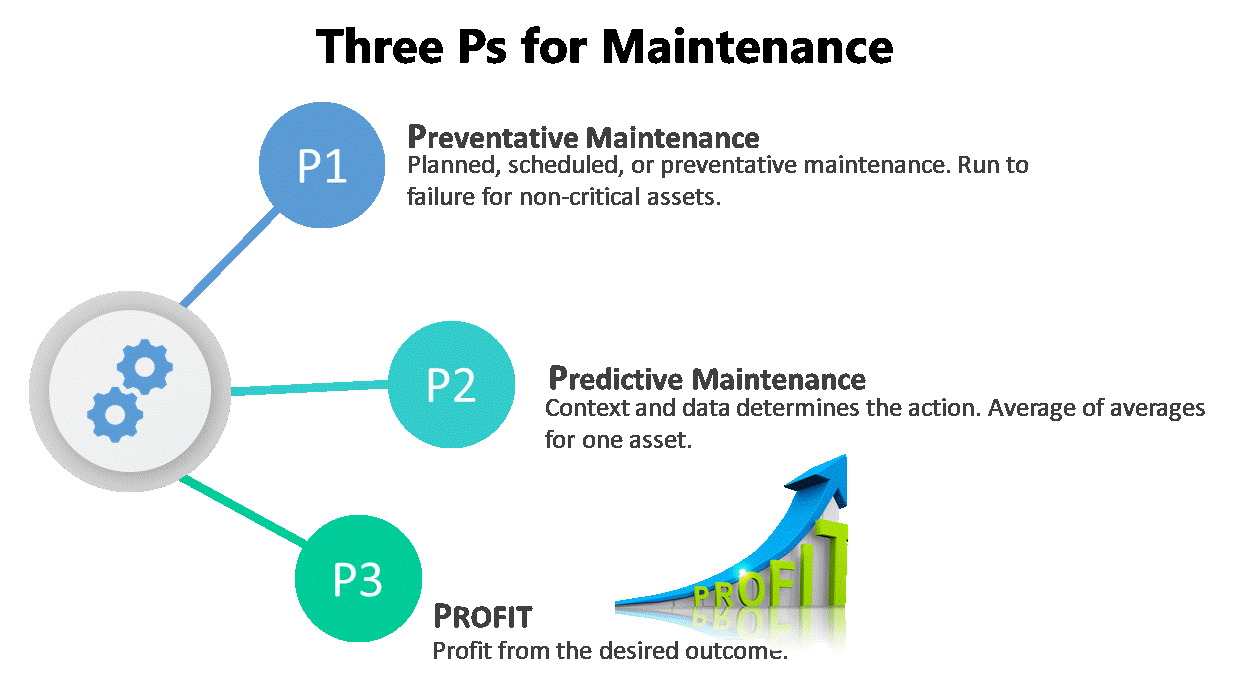

Alliteration adds confidence. There is something about a string of repeated characters that suggest the listed words are more related than they may actually be. Doug Laney’s proposition back in 2000 that big data is defined by volume, variety and velocity, for example, is - to me - artificially convincing. This becomes obvious when consultants got hold of it and start stringing on a fourth (“value”), fifth (“veracity”), and sixth (“validity”) V-word to differentiate their perspectives. Trailing the three Vs of big data, the three Ps of maintenance (planned maintenance, preventive maintenance, and predictive maintenance) are a distant second but show up more frequently as new analytics offerings accelerate access to predictive insights.
Predictive maintenance in particular is rapidly gaining attention as a part of the industry narrative around machine learning. The issue is that this list, which you can see in any standard process manufacturing vendor presentation, has got the wrong P as the third element. I believe that the ultimate state of maintenance is not prescriptive, but “profit.”
To begin with, the starting point for maintenance models is missing from the list of Ps. The first maintenance level should be run to failure, a valid approach for some low value and non-essential assets. The headlights in your car, if we’re using a car analogy.
The first P then is planned, scheduled, or preventive, maintenance. This approach is based on best practices or learnings from a fleet of assets, so the experience of the group defines the plan for an individual asset in the group. This is the “average of averages” approach: change your oil every 12 months or 7,500 miles, whichever comes first, say the oil change vendors.
The second P is predictive and is used for an asset pool of one: an asset’s specific context and data determines the plan of action. If planned is for windmills in a windfarm, predictive maintenance is associated with turbines and other high-value assets. The change here is with lower cost data generation, collection, storage, and analytics—predictive analytics can be applied to lower and lower value asset classes. The change oil light in your car comes on, an analysis of one engine at one point in time.
Then to the third P. The attention on prescriptive is because it sounds definitive. Prescriptive means “do this based on what you know will happen (predictive = future experience).” At first glance this sounds advantageous, but with further consideration, appears misguided. How can someone reasonably (responsibly) write down every possible outcome and corrective action? What happens when something happens outside the bounds of what was considered when the prescriptive responses were defined?
Back to the car example. A car shutting itself off when the oil pressure light comes on and you’re driving to the hospital is the wrong outcome. That sounds silly but if “operator override” is the critical input, why pretend to create a prescriptive strategy that will be overwritten in the moment?
And what, in the moment, will be the priority? Profit. In the car and hospital analogy, profit means getting either to (or closer to) the hospital end point. It’s the bigger picture desired outcome. In a plant context, it’s profit, not the experience or cost of any asset, that should be the desired outcome.

This is obvious to some, but will be a change in experience for many employees. Rather than the asset, the process, or the batch outcome—overall business profitability is the driving factor. But given insufficient analytics capabilities and the challenge of finding insights in a reasonable time, it was outside the abilities of engineers to optimize at the profit or business level.
Consider what’s required to optimize profit: a combination of data sources, analytics, and context must be evaluated in the time it takes to impact the outcome of a batch or process. This is the argument of industry visionaries such as Peter Martin of Schneider Electric, who has advocated for new solutions that optimize for business outcomes, rather than an individual asset, line, or even a plant.
As we've seen with today's advanced analytics solutions, users can now make near real-time tradeoffs in dollars and cents on their maintenance decisions. So, if the predictive maintenance insights suggest one course of action, but a detailed understanding of the costs and benefits of continued (even if suboptimal) production suggests another, they can make the right decision for the benefit of the organization. This is what is new, a level of accuracy and timeliness of insights enabled by advanced analytics solutions.
There is little doubt in the momentum behind predictive analytics and its accessibility to a broader set of assets and organization. The opportunity is to build on predictive insights to pursue the best course of action for the organization, and in general to redefine the maintenance Ps to capture what is now possible, and will become the alternatives models:
Planned. Predictive. Profit.
About your Guest Blogger
Michael Risse is Vice President at Seeq Corporation, a company building advanced analytics applications for engineers and analysts to accelerate insights on IIoT and process manufacturing data. He was formerly a consultant with big data platform and application companies, and prior to that worked with Microsoft for 20 years. Michael is a graduate of the University of Wisconsin at Madison, and he lives in Seattle, Washington.

